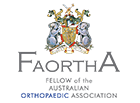Preoperative and Postoperative information – Arthroscopy
Prior to Surgery
Arthroscopy of the knee is usually performed to treat internal knee problems such as articular cartilage (joint surface) damage, meniscal tears, loose bodies, arthritis, or ligament surgery. On occasions, arthroscopy may be used for other conditions, which will be explained to you by Nigel. You will be given an information pack for arthroscopy on the day you are booked for surgery. Simple arthroscopy procedures are carried out in a hospital as a day case. Rarely, you may require an overnight stay for medical reasons. It is unusual that extra tests will be required however Nigel will ask if you:
- have any medical conditions
- are on any medications
- have any allergies which may mean you may need to have further tests or be referred to a physician for further assessment
On the day of surgery
- You will not meet the Anaesthetist generally until just prior to surgery
- If you take any blood thinning medication, please tell Nigel as in certain cases you may need to stop this medication for a period of time prior to surgery
- You must have nothing to eat or drink for at least 6 hours prior to surgery
- Your leg will be washed with an antiseptic solution.
- Nigel will come and have a talk with you and place a mark on the correct limb that is going to be operated on
- Nigel’s assistant surgeon will introduce themselves to you
- A physiotherapist will meet with you to give you crutches, simple exercises to do following surgery, and answer any other questions you may have
- In most cases surgery is carried out under a general anaesthetic
In surgery
- You will have an intra-venous (IV) line placed into a vein on your hand or forearm
- You will be given oxygen to breathe and the Anaesthetist will then drift you off to sleep
- A final check will be done to confirm all your details are correct, that the correct limb is marked, and the correct operation is being performed
- A torniquet will be placed around your thigh to restrict blood flow to the knee, to enable the operation to be performed
- No antibiotics will be given unless deemed necessary
- Your leg will be washed again with an antiseptic solution and then surgical drapes will be placed around your limb and body
- Two small cuts will be made at the front of your knee so that the arthroscope is introduced into the knee
- The operation will then be performed
- Initially a thorough examination is made of the entire knee and then particular reference is made to the problem as discussed with Nigel
- Cartilage damage, loose bodies and arthritis are then treated with small instruments that may be introduced through a second puncture wound on the other side of the knee-cap
- At the end of the operation local anaesthetic will be placed into the incisions (cuts) at the front of your knee
- The incisions (cuts) around the front of your knee will be steri-stripped together and a tubigrip stocking placed over your knee
- You will then be taken to the recovery room and eventually back to the day surgery unit
Immediately after surgery
- You will wake up in recovery
- You will feel some discomfort in your knee, which should be easily managed with painkillers or an anti-inflammatory medication.
- You will be encouraged to get up and about, and walk
- You will walk with a limp and may need to use crutches for up to a week in some cases or longer depending on what operation was done
- If you have had a meniscal repair you will require crutches and your weight- bearing on that leg will be different compared with having your meniscus removed
- Photographs and video are taken of your knee during the operation which will be given to you as a DVD
You will find 2 small puncture wounds under the dressing covering your knee, which are closed by steri-strips (or occasionally a suture). These wounds are small, but the surgery inside your joint is significant and your knee will take time to recover. It is important that you follow the instructions on this sheet to help healing, to maintain muscle strength and movement of your knee
Nigel will have a chat with you after your operation to discuss the findings of your arthroscopy.
An appointment card will be given to you to see Nigel 2-3 weeks following your operation.
Post-Surgery
For the first 3-4 days you need to elevate your knee (sitting in bed/couch). Ice your knee regularly and do light exercise. By day 3 you may start to walk around more.
Progress
It is important not to push your knee too hard, as this will slow healing. Signs that you are doing too much include: increased swelling / pain / stiffness temperature in the joint.
Puncture Wounds
- This area should remain dry until the steri-strips are removed 10-14 days post-operation.
- These areas may be slightly tender and puffy for 1-2 months post- operation and will benefit from gentle massage once healed. The area should remain dry until the steri-strips are removed 10-14 days post- operatively.
- Wrap a plastic bag / glad-wrap around your knee when showering.
- There may be some bleeding from the puncture sites. This is nothing to worry about generally.
- Excessive bleeding may require re-dressing. Please call the hospital where the surgery was performed or Nigel’s rooms if this occurs.
Swelling
The amount of swelling following an arthroscopy varies and tends to be dependent on the pre-operative state of your knee, and how much is done to your knee during surgery. An increase in the amount of swelling in the early post-operative days indicates that you are doing too much. It is important to decrease the amount of swelling as quickly as possible.
This can be achieved by:
- Not overdoing things
- Using crutches to reduce the weight
- Keep the leg elevated as much as possible
- Using a compression bandage
- Using ice at regular intervals
- You should check your leg frequently to ensure that it is pink in colour and NOT white or blue, as this may indicate ice burn. You may apply ice (wrapped in a wet towel) 3-4 hourly, for 30-minutes duration. (Frozen vegetables can be used). Please use a barrier between the skin and the ice.
Pain
- The most important part after your surgery is to keep your pain under control. This is done with medications.
- The anaesthetist will give you a script for pain-killers and an anti-inflammatory if you do not already have them.
- The medication needs to be taken regularly especially for the first 4 days.
- If your pain is not controlled by the medication, please call Nigel’s rooms.
Crutches
Crutches are to be used to control weight bearing transmitted through your knee.
Full Weight Bearing
This means that you may take as much weight as comfortable through your operated leg. The crutches are used in this instance to help control swelling, pain and to assist in the healing and recovery of the joint. It is important that you contract your thigh muscles each time you take weight through your operated leg. You may discard your crutches when you can walk without pain and the swelling around the joint has reduced.
Stairs
- Walking and movement are encouraged to help get the knee moving
- It is extremely important to use crutches when you negotiate stairs
Remember this sequence
- WHEN GOING UPSTAIRS: Good leg, operated leg, then crutches.
- WHEN GOING DOWNSTAIRS: Crutches, operated leg, then good leg
Driving
You may resume driving around 2 days post operatively.
Work
Work activities depend on the job that you do and Nigel will advise you of an appropriate time to return to your work. If you work in an office you may return to work when you feel comfortable to do so. Active jobs will need longer periods off work up to 4 weeks for manual labourers.
Sports
Sports activities should not be attempted before 4 weeks at the earliest but again Nigel will advise of when you can return to these.
Complications
Even though arthroscopy is a small, effective and quick operation, complications can occur.
Bruising
Bruising is common following arthroscopy and may occur around the top part of your thigh (where the torniquet was), in your calf, or around your knee. It may take 2 weeks for this to settle down
Swelling
Your knee can be swollen for up to 6-8 weeks, and does depend on how much work was done in your knee joint
Swelling reduction with ICE is important and should be done regularly for the first 10-14 days
Infection
Is less than 0.5% (1/200)
- It is important to seek medical advice if you have any of the following:
- Feel unwell
- Increased pain in your knee or with movement
- Increased heat or redness around your knee
- Increased swelling of your knee
- If there is a creamy discharge from the wounds
- If you experience discomfort or feel lumps in your groin
- Any of these symptoms may indicate that you have an infection and it is important to seek medical advice as soon as possible
Blood clots (DVT)
Occur in 10-15% of patients having an arthroscopy of the knee.
Most cases are not picked up and do not cause problems.
But if you have:
- Increased pain or discomfort in your calf
- Increased swelling of your calf
- Increased pain with movement of your calf
- Your breathing pattern changes or you feel short of breath
Any of these may suggest you have a blood clot and you should seek medical advice as soon as possible.
Ongoing pain
Some patients may still have pain following surgery. This is not uncommon particularly in those who have arthritis (wear and tear) in their knee or those who have inflammation of their knee.
The locking or catching sensation will go but the pain may remain.
Recurrence of symptoms
In a small number of cases the locking or catching sensation may recur. This can be because Nigel has not taken out enough meniscus, there has been a further tear of the meniscus, or a new problem has arisen.
Important Note:
You may have discomfort, swelling, bruising and/or clicking in your knee for up to 8 weeks after your operation. These are normal occurrences post operation. However, after 8 weeks if you continue to have any of those symptoms please contact Nigel’s rooms. It is important not to overdo things after your operation as you may cause damage to your knee.



